There are various types of guitars and it can be sometimes hard to choose the right one. Each type of guitar offers unique characteristics and capabilities that address the diverse needs and preferences of musicians across genres and playing styles. Whether it’s the warm tones of a classical guitar, the resonance of an acoustic, or the versatility and power of an electric, there’s a guitar to suit every player’s needs and musical aspirations. But when you are buying a guitar for a child you should consider a few additional things in order to find the right guitar types. There are also some good alternatives to guitars. Let’s take a look at the details of each guitar type in this article.
Overview of Guitar Types
Most people would probably know that there are acoustic and electric guitars without having any guitar knowledge. This is a good distinction, but far from complete. An acoustic guitar doesn’t need electrical amplification. It has a hollow body that amplifies the vibrations of the strings. However, when guitarists talk about steel string acoustic guitars. Then there are acoustic guitars with nylon strings. These are called classical guitars. And of course there are electric guitars, which everyone probably knows.
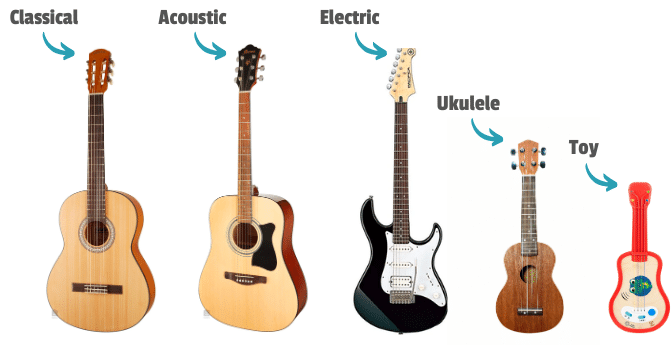
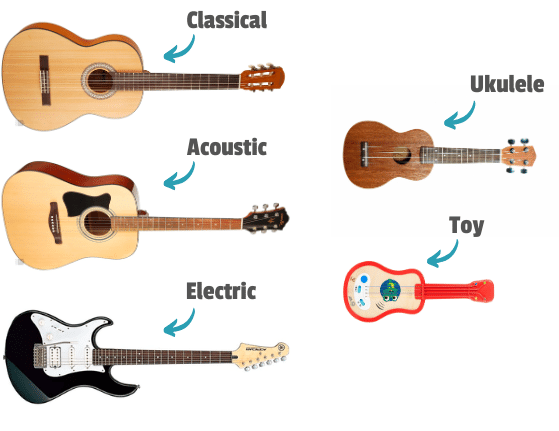
Those are the 3 main types of guitars. However, I would like to mention 2 other types as well, especially when it comes to guitar playing for kids. The first one is the ukulele. Let’s say a ukulele is the little brother of the guitar and a good alternative for kids and the reason why I want to talk about it as well. The second are toy guitars. They’re not real instruments, but it’s a good alternative for very young children.
Classical Guitars
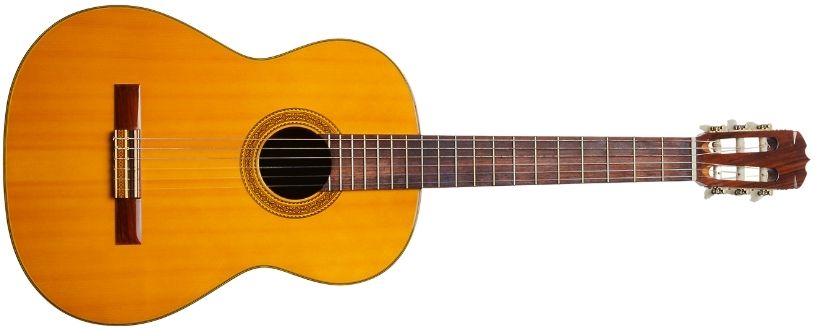
First of all, we start with the most popular type of guitar for children – the classical version. Its name does not mean that this guitar can be used only to play classical songs. On the contrary, your child will be able to play any kind of music with this instrument. The difference to the other models is in the construction. The classical version has a larger and flatter neck. The strings on this guitar are nylon strings, which is one of the most important facts when it comes to children’s guitars. Nylon strings are much more comfortable for children’s fingers and do not hurt as much as steel strings in the beginning. Of course, once the fingers get used to the strings, they will not hurt anymore, but until then it is a fact to consider, as many beginners tend to give up when the strings hurt too much. This is why beginners and therefore younger children should start playing on classical guitars.
When buying a classical guitar for children you should get it in the right size. A guitar has to fit like a good pair of shoes. Otherwise, it’s hard to learn and to play the new instrument. Check out our article about guitar sizes in order to find the right one.
Sound Example:
Acoustic Guitar
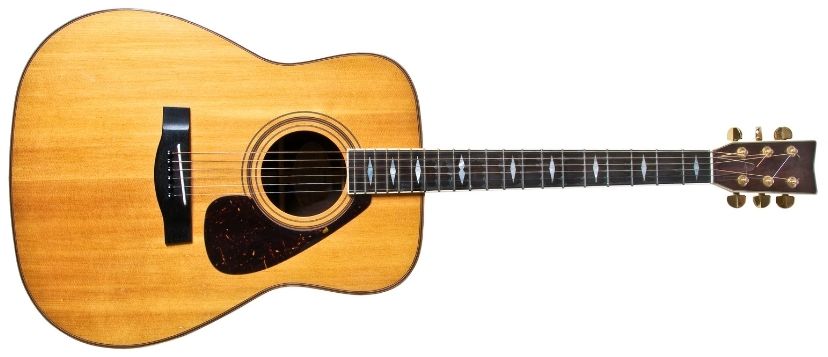
Unless you are a guitarist, it might be hard to tell if a guitar is a classical guitar or a steel string guitar. At first glance, they look quite similar, but a closer look reveals that there are many small differences. The biggest difference can be found by comparing the heads of the two guitars (see picture below). A classical guitar has an open head, while the steel string version has a closed head. Keep this in mind, as it is the best and easiest way to distinguish these two types. Another difference is the width of the neck. The neck of a steel string guitar is narrower than that of a classical guitar. As a result, you have to place your chords much more precisely because the space between the strings is much narrower.
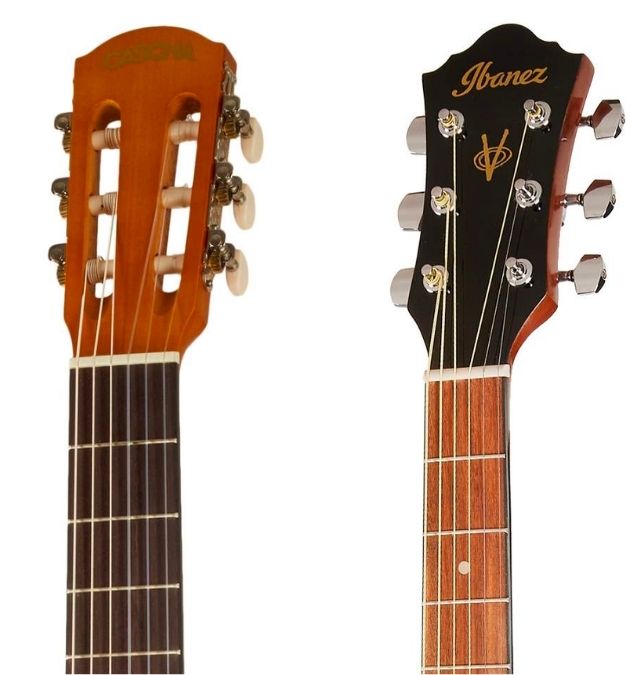
Besides the differences in construction, there are also significant differences in sound. As the name implies, acoustic steel string guitars use steel strings that produce a metallic, loud sound. They have a bright, crisp tone compared to classical guitars with nylon strings. Steel string guitars are primarily used for rock, country and pop music. It is often the case that guitar beginners start out on a nylon string guitar because the strings are much softer and more comfortable to play. Once most guitar players have reached an advanced level, the majority of them switch to an acoustic guitar. There are also electro-acoustic guitars, which have an electronic device (called a pickup) that captures the vibration of the strings and amplifies the sound of the guitar. If your child wants to perform in public or on stage, an electro-acoustic guitar would be a good choice.
Sound Example:
Electric Guitar
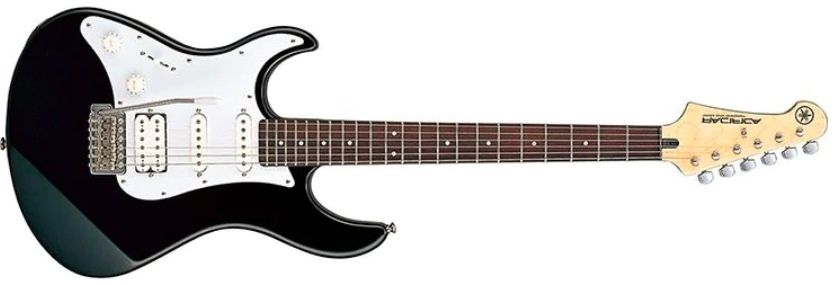
Electric guitars generally differ from other guitars in two main ways. First, they are solid body guitars. The body of the guitar is made of solid wood. This is an important fact to consider, especially for young children, since electric guitars are much heavier. Secondly, they need to be amplified electronically to hear their sound. This is done by using an amplifier that is usually connected to the guitar with a cable. Although children are often tempted to start on an electric guitar, parents should know that a classical guitar is usually the best choice for beginners. The sound and volume of electric guitars can be adjusted with an amplifier. If your child is too young, it may be too complicated to handle all the buttons on the guitar and the amplifier. In addition, it requires a certain amount of responsibility to respect household volume levels. When amplified, it produces a metallic sound with a long decay. They use steel strings, but their strings are quite thin compared to acoustic guitars. This type of guitar is mainly used to play rock, blues, jazz or pop music.
Sound-Example:
Ukulele
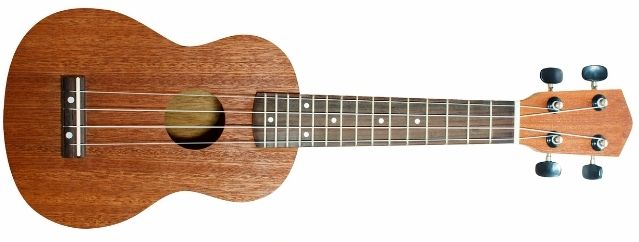
A ukulele looks a lot like a regular guitar, just a lot smaller and lighter. But the biggest difference is the number of strings. It has only 4 strings instead of 6. The chords on the ukulele are much easier to learn than on the guitar. Some of them only require the use of one finger. So the ukulele is an instrument where you can progress quite quickly in the beginning and this is a good point especially for children. Kids will progress much faster on the ukulele than on a regular guitar. A good ukulele is also much cheaper than a guitar. There are also a lot of parents out there who buy their children a ukulele as a toy. You can do that as well, but you should know that you are not getting a real musical instrument. For more information on this great little instrument, visit our kids ukulele section.
Sound Example:
Guitar Toys
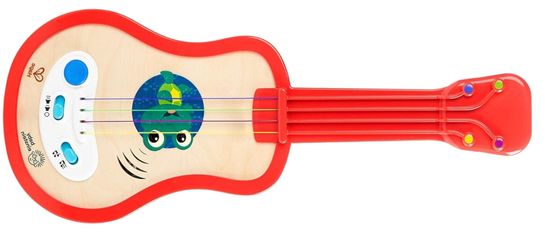
Well, a toy is not a musical instrument, but to be honest, a guitar toy can be a great introduction to the world of guitars for toddlers and even babies. Don’t make the mistake of giving your son or daughter a real guitar too soon. If you are not sure that your child is mature enough and therefore not ready for a guitar, then go for a toy. There are great ones out there that offer a variety of features.
Find the best guitar for kids in our overview article.


